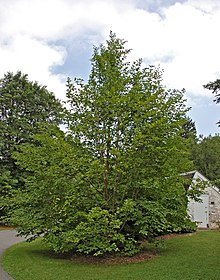Stewartia pseudocamellia
| Stewartia pseudocamellia | |
|---|---|
 |
|
| Scientific classification | |
| Kingdom: | Plantae |
| (unranked): | Angiosperms |
| (unranked): | Eudicots |
| (unranked): | Asterids |
| Order: | Ericales |
| Family: | Theaceae |
| Genus: | Stewartia |
| Species: | S. pseudocamellia |
| Binomial name | |
|
Stewartia pseudocamellia Maxim. |
|
Stewartia pseudocamellia, also known as Korean stewartia,Japanese stewartia, or deciduous camellia, is a plant species in the genus Stewartia in the family Theaceae, native to Japan(southern Honshū, Kyūshū, Shikoku) and Korea.
It is called natsutsubaki(ナツツバキ, "summer camellia") in Japanese, and nogaknamu(노각나무, "overripe cucumber tree") in Korean.
It is a small to medium sized deciduous tree, growing to 10–15 m (rarely to 18 m) tall often with multiple stems and/or low branching trunks. The bark is smooth textured, exfoliating as the plants age, and has a camouflaged or mottled appearance with patterns of dull orange and green with grey mixed in. The trees are pyramidal to rounded in shape with deep green coloured foliage. Young stems have a zig-zag shape with flattened, divergent buds. The leaves are 4–12 cm long and 2.5–5 cm broad, arranged alternately on the stems with an elliptical shape and finely serrated edges. In the fall the foliage turns yellow, red or purple. The flowers are up to 8 cm wide, with five white petals with orange anthers; they are shaped like those of the related Camellia, round and flat to somewhat cupped. They are produced in summer, generally in June until the end of August; each flower is short-lived, but many are produced that open over many weeks. The fruit is a brown capsule, triangular in shape with four or five angles, persistent on the trees but not showy.
There are two varieties:
...
Wikipedia
